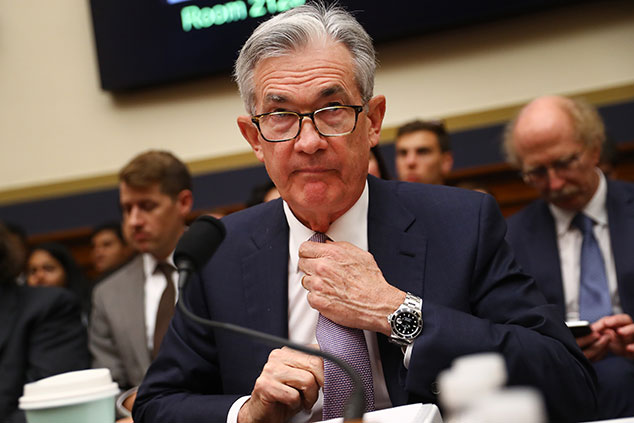
This article is taken from our FREE daily investment email Money Morning.
Every day, MoneyWeek’s executive editor John Stepek and guest contributors explain how current economic and political developments are affecting the markets and your wealth, and give you pointers on how you can profit.
OK, he’s got me convinced now.
Federal Reserve chair Jerome Powell – or whoever is in charge of policy at America’s central bank – definitely gets it.
His job is to keep the stockmarket rally going for as long as he can feasibly get away with it.
And that’s exactly what he’s going to do.
Full employment, solid growth, record high market – better cut rates
The S&P 500 stock index is at a record high, having popped above 3,000 for a time yesterday. US GDP is growing at around 3% or so a year. The US is as close to full employment as it’s ever been. Inflation is sitting at a bit below 2%, but it’s positive. Wage inflation is higher than that, at around 3%.
So what’s the next logical move for the Federal Reserve? To cut interest rates, of course!
The market has been bullying the Fed to cut interest rates ever since it started increasing them. A hissy fit during the last quarter of 2018 was enough to put paid to the raising cycle. And over the course of the first half of this year, Powell managed to back himself into a corner whereby markets were half-convinced that he’d cut interest rates by half a percentage point at the end of this month.
Friday’s US unemployment data rattled the horses for a moment. The stronger-than-expected figures cast doubt on the idea of there being any rate cut at all, which sent markets lower. That’s why yesterday’s Fed data and Powell’s testimony to Congress, along with the minutes from the last Fed meeting, were so important.
This was Powell’s chance to manage markets’ expectations. If he’d thought that markets were wrong to hope for a rate cut this month, this was his chance to tell them.
Instead, he gave them exactly what they wanted. An extremely dovish set of minutes was accompanied by a very dovish testimony to Congress. Powell put as negative a spin as he could on the most recent economic data, and made it blindingly obvious to markets that a cut is definitely coming.
Indeed, he was so dovish that markets went back to believing that there’s a better-than-outside-chance of a 0.5% cut, rather than just a quarter point one.
Is this about keeping Donald Trump happy, as some would like to argue? Probably not. People get way too excited about the independence of the Fed, and central banks in general. It’s a fig leaf at best. It enables politicians to deflect responsibility for difficult decisions. It stops us from getting clearly politically-motivated rate cuts ahead of elections.
But otherwise, central banks follow the path of least resistance, just like every other human being. And until inflation is so high that people are begging for the Fed to raise rates (and even then, it won’t be popular, as Paul Volcker could probably tell you), then the path of least resistance is always down.
This is great news for investors’ portfolios – at least until the next crash
The reality is that it doesn’t matter anyway. From an investor’s point of view, this clarity is useful. Up until now I have to admit I was conflicted. I knew Powell had performed a U-turn, but I wasn’t quite sure that he’d embraced the “always be more dovish than the market expects” philosophy of his predecessors. But now we know that he has.
I was chatting to Helen Thomas of economic consultancy Blonde Money the other day (she’s very smart and you should follow her on Twitter – @marketblondes). She pointed out to me that Powell is not in charge like Yellen and Bernanke were; he just wants a quiet life. Instead the main drivers of Fed policy now are the dovish members like vice chairman Richard Clarida.
This contingent are keen on the idea of cutting as “insurance”. In effect, as long as inflation isn’t roaring ahead, you might as well keep rates as low as possible. So that’s where we are now.
Be in no doubt, this is good news for risk assets (ie, your investments). As long as the Fed stays ahead of the European Central Bank (ECB) in playing the game of “who’s the biggest dove?” – and it’s certainly easier for the Fed to do that – then the US dollar will weaken. And as long as the US dollar is weakening, it’s hard to be a bear.
This, of course, creates massive complacency, which creates rampant moral hazard. Which in turn creates bubbles. Which in turn create the conditions for a massive market crash eventually, one way or another.
What will those conditions be? Sometimes assets just get too expensive. Sometimes something breaks somewhere – politics is a messy business at the moment, and maybe at some point it’ll get messy enough to cause genuine problems for assets (you know – confiscation, hyper-intrusive regulation and the like).
I still suspect that at some point that inflation will take off, possibly driven by a combination of capital misallocation, and the end of the globalisation dividend. The one obvious problem that central banks can’t solve in a market-friendly way is inflation.
And if the looming political policies on which the next elections will be fought can’t force inflation to take off, then maybe we really have solved all of our scarcity problems. Which would be nice. But it seems unlikely.
In the meantime, as I always say, hold some gold in your portfolio in case something breaks.
We’ll be talking about all of this in a lot more detail at the MoneyWeek Wealth Summit in November. If you haven’t booked your ticket already, get it here.